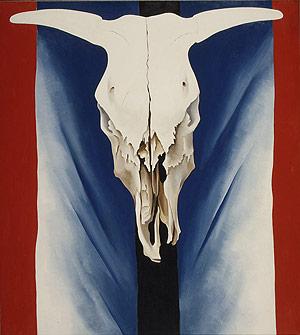Georgia O'Keeffe Gallery
Georgia O'Keeffe (American, 1887–1986)
Oil on canvas; H. 39-7/8, W. 35-7/8 in. (101.3 x 91.1 cm)
Alfred Stieglitz Collection, 1952 (52.203)
"Red, White, and Blue," one of O'Keeffe's most famous works, is among her earliest studies of a single animal bone isolated from its natural environment. Despite its Southwestern subject matter, the painting was most likely done in Lake George during fall 1931. The cow's skull was one of several bones O'Keeffe had shipped East the year before, with the intention of painting them. The interesting shapes and textures of the bones and their natural play of positive form and negative space repeatedly inspired her to depict them. She saw in their jagged edges, worn surfaces, and pale color the essence of the desert — a beauty that was enduring and untouchable. O'Keeffe was able to create compositions of extraordinary simplicity that can be appreciated on many levels. "Red, White, and Blue" is masterful, both as an eloquent abstraction of form and line and as a richly symbolic image that raises issues of nationalism and religion. The compositional arrangement is starkly simple. The skull, precisely modeled and strictly frontal in its placement, becomes an image of great mystical power, like a sacred relic. The religious connotation is reinforced by the cross configuration of the extended horns and vertical support (probably the tree or easel upon which the skull was hung). Only a few years before, O'Keeffe had produced a number of dramatic depictions of the actual wooden crosses found in the New Mexico landscape. In the 1930s, when this painting was executed, artists, musicians, and writers were interested in developing an indigenous American art form. It was an idea strongly supported by Stieglitz and his circle of artists, who sought to develop an American style of painting, rather than depictions of American subjects as produced by the Regionalists and the Social Realists. "Red, White, and Blue" is symbolic of America as O'Keeffe saw it, represented by the New Mexico desert and its relics; and almost as a joke, she painted the canvas with the three colors of the American flag.

viewer |
|
|
Red, White, and Blue |
| Sky |
| Cottonwood |
| Storm |
| White Rose with Larkspur |
| Shell |
| Green Patio Door |
| Leaves of a Plant |
Biography
Bulletin Board
Renowned Art
(home)
O'Keeffe was born in Sun Prairie, Wisconsin. During the 1920s, her large canvasses of lush overpowering flowers filled still lifes with dynamic energy and erotic tension, while her cityscapes were testaments to subtle beauty within the most industrial circumstances. She married Alfred Stieglitz in 1922. For the next twenty years the two would live and work together, Steiglitz creating an incredible body of portraits of O'Keeffe, while O'Keeffe showed new drawings and paintings nearly every year at his gallery. When Steiglitz in 1946 died, O'Keeffe took up permanent residence Taos. In 1977 her she received the Medal of Freedom, and in 1985 she received the Medal of the Arts.
all artists, with thumbnails: by birth year | alphabetically
all artists: by birth year | alphabetically
artists born in the 13th 14th 15th 16th 17th 18th 19th 20th century